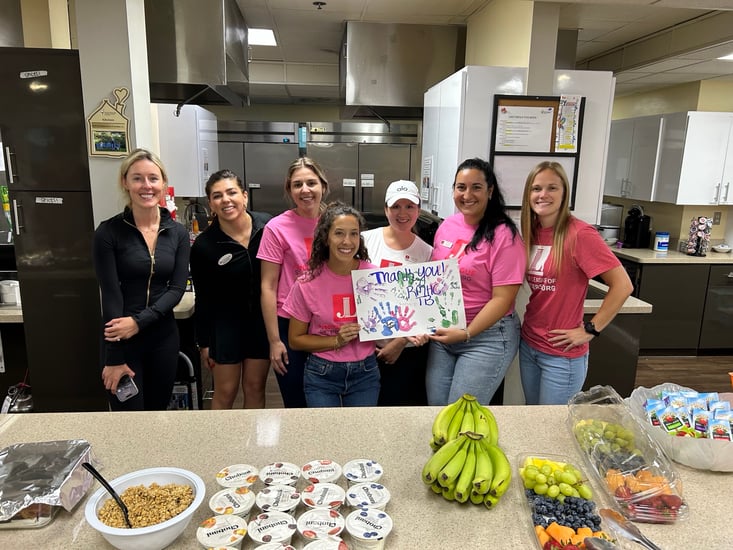

Related Posts
Subscribe to Our Blog
Subscribe to receive email notifications every time we publish new insights, news, and thought leadership to our blog.

Ronald McDonald House Charities (RMHC) of Tampa Bay is a vital part of Florida’s healthcare support system, offering comfort and stability to families when they need it most. With a mission to remove barriers to healthcare access for families with sick children, the organization has created a compassionate environment centered on community support. We spoke with Bree Tramontana, Associate Director of Corporate and Community Engagement, about the impact of volunteers on their mission and how VolunteerHub has streamlined their efforts.
Bree: I straddle both the development/marketing side and operations. My role revolves around connecting people in our community—whether individuals, corporate groups, or student organizations—with purpose. That purpose is Ronald McDonald House. We envision a world where every family has access to the healthcare they need for their children to achieve the best possible outcomes. Often, that means providing housing, meals, and respite services so parents can remain close to their child’s bedside during treatment.
Bree: Our focus is always on service excellence. We measure success by the direct impact we have on families, are we meeting their needs? Do they feel supported? With 91 bedrooms across five houses, we consistently operate at 85–87% capacity and often hit 100%. That tells us families are finding value in our services. We’ve also maintained a four-star Charity Navigator rating, which only 13% of nonprofits achieve. That kind of recognition speaks to our mission-driven decision-making.
Bree: Volunteers are essential. With 60 staff across five locations, we simply couldn’t meet the demand without them. We currently have about 200 active individual volunteers. Pre-COVID, they filled the equivalent of eight full-time positions. We’re now at around four full-time equivalents—still representing hundreds of hours a week of support. They staff our reception desks, help with daily tasks, offer tours and serve meals. Last year alone, volunteers helped us provide over 50,000 meals. Their support allows our staff to focus on specialized tasks and family engagement.
Bree: We struggled with inefficiencies in onboarding and scheduling, especially for groups. Our old systems lacked workflows and required a lot of manual documentation. We were paying per active user, so we couldn’t have people in the system until they were fully onboarded. Everything had to be tracked separately via emails and shared files. It was time-consuming, redundant, and prone to errors.
Bree: The workflows have been a game changer. With previous systems, we struggled a lot—there were no workflows, so we had to manage everything manually through emails or shared internal documents. We couldn’t keep people in the system unless they were fully onboarded, because we were charged per user. That meant we couldn’t track or engage with people who were in the early stages of the process. There was no way to create a holding space for potential volunteers. Everything had to be duplicated, uploaded, or done outside the system.
VolunteerHub changed that entirely. Now, we can segment and track people who are in the pipeline, automate onboarding steps, and manage them through user groups—even if they haven’t completed training yet. We can communicate with them easily and efficiently. The ability to email volunteers through the system, with messages that come from me, is huge. Volunteers recognize my name, so they read the emails. It saves so much time, reduces confusion, and increases engagement across the board. In other systems, we have used to send email from the system itself and don’t include the sender’s name.
Bree: Fantastic. Matt and Jen from the VolunteerHub team made everything so easy. They were patient, and knowledgeable, and offered extra support when we needed it. They even guided us on best practices from other RMHC chapters and encouraged us to use resources like the Facebook group and online help tools. Their responsiveness—sometimes within 10 minutes—was amazing, especially considering our team operates across five locations and multiple shifts.
Bree: Very positively. Group volunteers, especially those providing meals, love the forward-facing calendar and ability to self-schedule. It’s eliminated a huge scheduling burden from our team. Individual volunteers appreciate the modern look, better tracking of their contributions, and the simplicity of the interface. We’ve had repeat volunteers say it’s a significant improvement over our previous system.
Bree: The workflows, group email capabilities, forward-facing calendars, and the ability to manage everything, including waivers and documents, within the system. We also love the ability to create and save templates, which saves us from constantly recreating the same content. It’s made our operations more efficient and scalable.
Bree: For us, VolunteerHub is like a part-time employee. It’s taken over administrative tasks that used to consume a lot of staff time. It supports both group and individual volunteering, which is rare. Furthermore, it has helped us streamline onboarding, track communication, and centralize all volunteer-related information. The system allows anyone on our team to provide accurate, up-to-date information, even if someone from the Volunteer Services team is out.
Bree: There are so many ways to get involved! Whether you have a specific interest or limited availability, we have opportunities to match. The best place to start is our website. From there, you can sign up for a meal program, fill out a volunteer inquiry, or complete our screening application for individual opportunities. Everything is streamlined, and our volunteer services team is ready to help you find the right fit.
Subscribe to receive email notifications every time we publish new insights, news, and thought leadership to our blog.